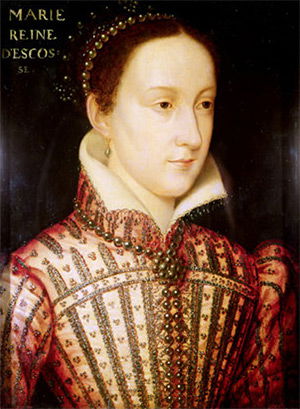Mary Queen of Scots France Goodbye France I May Never See You Again Mary Queen of Scots
 When her armada of galleys and cargo ships left Calais the 18-year-old Queen of Scots and Dowager Queen of France burst into floods of tears as she said cheerio to ma chère French republic and sailed on a journey to what for her was most an unknown state. Mary had been Queen of Scots since she was a baby, but a calendar week former. At the age of five she was sent to French republic to go on her out of the clutches of the English language. At 15 in 1558 she was married to the future Francis II, who was 14. It is idea that she was probably still a virgin when he died two years later. Catherine de Medici, the French queen mother, no longer wanted her in France and Mary decided that her time to come lay in Scotland.
When her armada of galleys and cargo ships left Calais the 18-year-old Queen of Scots and Dowager Queen of France burst into floods of tears as she said cheerio to ma chère French republic and sailed on a journey to what for her was most an unknown state. Mary had been Queen of Scots since she was a baby, but a calendar week former. At the age of five she was sent to French republic to go on her out of the clutches of the English language. At 15 in 1558 she was married to the future Francis II, who was 14. It is idea that she was probably still a virgin when he died two years later. Catherine de Medici, the French queen mother, no longer wanted her in France and Mary decided that her time to come lay in Scotland.
The Scottish fleet that came to Calais for Mary was commanded past the loftier admiral of Scotland, who happened to exist the same Earl of Bothwell who was destined to play a sinister role in her later life. The journey to Leith, the port of Edinburgh, took less time than expected and when she landed Mary had to get to a local merchant'south business firm until noblemen led past her illegitimate half-brother Lord James Stewart, Earl of Moray, came to escort her to Edinburgh where crowds had gathered to cheer her on her way up to Edinburgh Castle. Young, tall, graceful and vivacious, she fabricated an fantabulous impression and bonfires blazed merrily equally she presided over a feast. Later she had retired for the night a crew of 500 or more amateur musicians kept her awake by scraping fiddles and singing psalms out of melody exterior. In the morning, with her usual good-natured charm, she sweetly thanked them.
Mary's abode in Edinburgh was Holyrood Palace, which had been rebuilt by her male parent, James V. Her rooms in the north-west belfry included her presence chamber for receiving visitors, her bedchamber, a small supper bedroom and a combination stool chamber and dressing room. The palace had a large deer park where she went hunting and she congenital an extra bath house where allegedly she liked to breast-stroke in white wine for her complexion.
The young queen spoke Scots fluently, just she was far more French than Scottish. She kept a excellent court on French lines and about of her household were French. Strict Protestants were horrified by the fact that Mary and her ladies danced at banquets and balls. John Knox, that pillar of cocky-righteousness who had already issued a denunciation of all female rulers in his The Commencement Nail of the Trumpet Against the Monstrous Regiment of Women (1558), said that the queen had brought with her to Scotland 'sorrow, dolour, darkness and all impiety'. He complained that Holyrood would shortly be a brothel and attributed the fascination Mary exercised on men to 'some enchantment whereby men are bewitched'. Mary's efforts to reason with him failed utterly. Equally fourth dimension would show, her bewitchery to men went with an unerring ability to option the wrong one.
Mary was popular with many of her subjects, just she faced serious problems. She was a Roman Cosmic and, although she attended Mass only in individual and appear that she had no intention of interfering with Scotland'south official Protestantism (while confidentially telling the pope the reverse), she aroused Protestant suspicions. Though she had the support of Lord James Stewart and others, the Scottish nobility was prone to lawlessness, violence, feuds and rapacity and was far from easy to deal with. Also she was past right of birth not only Queen of Scots but the nearest heir to the throne of England. Indeed the French maintained that Mary had a improve merits to the throne than Elizabeth I. Mary's refusal to renounce that claim earned her the hostility of Elizabeth, who would prove past far Mary's superior in statecraft.
Yet things went well enough for Mary's kickoff few years in Scotland, until in 1565 she became passionately infatuated with one of her cousins, Henry Stewart, Earl of Darnley. She said he was 'the best proportioned long human she ever saw' and she made the fatal mistake of marrying him. Non merely did she observe that Darnley was power-hungry, vicious and totally unreliable, but the preferment the marriage gave him and his branch of the Stewarts infuriated many of the Scottish nobles, peculiarly Mary'south correct-manus man, Lord James Stewart, who led a rebellion confronting her. To what extent Lord James secretly wanted the throne for himself has been debated ever since, but the Darnley matrimony was the get-go step on the long path to Mary'southward eventual overthrow and expulsion from Scotland, her years of imprisonment in England and her execution by the English in 1587.
Source: https://www.historytoday.com/archive/months-past/mary-queen-scots-leaves-france-scotland

0 Response to "Mary Queen of Scots France Goodbye France I May Never See You Again Mary Queen of Scots"
Post a Comment